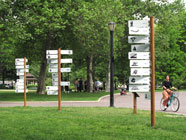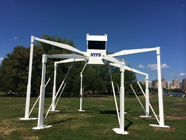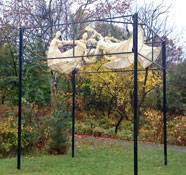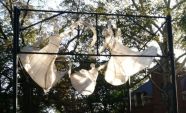Art in the Parks
Through collaborations with a diverse group of arts organizations and artists, Parks brings to the public both experimental and traditional art in many park locations. Please browse our list of current exhibits and our archives of past exhibits below. You can also see past grant opportunities or read more about the Art in the Parks Program.
Public Art Map and Guide
Find out which current exhibits are on display near you, and browse our permanent monument collection.
Search Current and Past Exhibits
2015
Queens
Bundith Phunsombatlert, Wayfinding: 100 NYC Public Sculptures
May 15, 2014 to March 29, 2015
Flushing Meadows Corona Park, Queens
Map/Directions (in Google Maps)
Please note: This is a past exhibit that is no longer installed in the park.
Wayfinding: 100 NYC Public Sculptures is a site-specific project that invites the public to embark on guided journeys through NYC to find public sculptures. Phunsombatlert researched all existing public sculptures in New York City and identified 100 sites to be incorporated in his final work. He then created small drawings of each sculpture and developed directional signs and maps that resemble standard U.S. National Park Service signage. The artwork is made up of signage for 100 public sculptures that contain distances drawn from GPS coordinates between each sculpture and the group of wooden posts outside of the Queens Museum at Flushing Meadows-Corona Park.
The project is made possible by the generosity of the Athena Foundation, Awesome Foundation, Foundation for Contemporary Arts, Location One, New York Foundation for the Arts’ Opportunity Grants, Puffin Foundation, Ltd., Puffin Foundation West, Ltd., Socrates Sculpture Park, Mark di Suvero, Anne Dunning, Rob Herschenfeld, James T. MacGregor & Claire Montgomery, Ivana Mestrovic, and Jan Mun.
![]()
Various, Emerging Artist Fellowship Exhibition
September 7, 2014 to March 22, 2015
Socrates Sculpture Park, Queens
Map/Directions (in Google Maps)
Please note: This is a past exhibit that is no longer installed in the park.
Artists: Matt Callinan, Jordan Griska, Meredith James, Fitzhugh Karol, Lilian Kreutzberger, Zaq Landsberg, Heidi Lau, Amanda Long, Christopher Mahonski, Kimberly Mayhorn, Eto Otitigbe, Brie Ruais, Edward Schexnayder, David Wilson, Dane Winkler
The annual Emerging Artist Fellowship (EAF) Exhibition is a cornerstone of Socrates Sculpture Park’s visual arts programming and is widely acclaimed for the ambition, breadth, and innovation of the works on view. Featuring fifteen artists, EAF14 is a survey of the compelling and diverse state of sculpture today.
Each EAF14 artist has engaged with the larger narrative of public space in a dynamic and daring way, building upon Socrates Sculpture Park’s goal to present socially aware, inspiring art in the public realm. EAF14 artists were selected through a high competitive process that attracted a broad field of nearly 300 candidates, reviewed by the park’s curatorial advisors Anne Barlow (Executive Director, Art in General) and Joe Sheftel (Joe Sheftel Gallery, New York). Selected EAF14 artists were awarded a 2014 Emerging Artist Fellowship, including 24/7 access to the park’s outdoor studio and facilities, as well as the financial, technical, and curatorial support to realize his or her most ambitious work possible.
This project is presented by Socrates Sculpture Park
![]()
Kate Gilmore, Wall Bearer
September 7, 2014 to March 22, 2015
Socrates Sculpture Park, Queens
Map/Directions (in Google Maps)
Please note: This is a past exhibit that is no longer installed in the park.
Kate Gilmore’s sculptural and performance-based works raise questions about feminine identity and contemporary power dynamics. Wall Bearer, the park’s current Broadway Billboard, is documentation from the eponymous performance at The Weatherspoon Art Museum in Greensboro North Carolina in 2011. For that project, six performers, dressed in identical pink outfits, stood in individual alcoves within a matching pink wall.ÃΑΑÃΑÂ The performers, all women, stood perfectly still for three hour stretches, during which time visitors to the exhibition could walk through the space, viewing the performance as a still-life or a sculpture to be briefly admired.
In Wall Bearer, the live female body is transformed into a sculptural element, referencing 1970’s performance art and later feminist artworks.ÃΑΑÃΑÂ Here Gilmore presents a parade of pink and a rotating cast of all-female performers. The pink’s Pepto-Bismol-like hue borders on saccharine and feels imposed and thus unattractively burdensome for each woman. Camouflaged, anonymous, and uncomfortable, each woman may be a column of support and essential to the overall tableau, but she is also easily overlooked, suggesting that there is more than a physical wall to be overcome.
This project is presented by Socrates Sculpture Park
![]()
Staten Island
DB Lampman, The Dance
November 9, 2015 to October 28, 2016
Conference House Park, Staten Island
Map/Directions (in Google Maps)
Please note: This is a past exhibit that is no longer installed in the park.
The Dance consists of five figures floating 15 feet above the ground. The figures, formed with steel and wrapped in nylon, hold hands and dance whimsically within a rectangular steel structure. At night the figures light up and cast a glow around the neighboring trees. The Dance is inspired by Henri Matisse’s painting by the same name. Similar interlocked figures can be found throughout art history, including Mayan art, African tribal sculptures, and ancient Mesopotamia, among others, to symbolize family, community, and spiritual or universal connectivity. Lampman uses this symbol for the coming together of the Staten Island community.
Lampman lives and works in Staten Island and has embraced the diverse community made up of residents from around the world. In the exhibition, the five figures are entwined in a dance—they could be Flamenco dancers from Mexico, Kandyan dancers from Sri Lanka, or a dance from West Africa such as the Yankadi, or the Makru.
Many Staten Island neighborhoods were flooded during Hurricane Sandy, and sadly lives and homes were lost in the storm. However, Staten Island came together during this crisis—strangers dropped everything and join people from around the island and all over the world to rebuild the community. The neighborhoods’ joint effort is an integral part of the inspiration for Lampman’s public artwork. Additionally, Lampman hopes that the installation will inspire additional community development, as the informal pavilion can be used for public dance and music performances by community members.
![]()
DB Lampman, The Dance
September 15, 2014 to September 14, 2015
Tappen Park, Staten Island
Map/Directions (in Google Maps)
Please note: This is a past exhibit that is no longer installed in the park.
The Dance consists of five figures floating 15 feet above the ground. The figures, formed with steel and wrapped in nylon, hold hands and dance whimsically within a rectangular steel structure. At night the figures light up and cast a glow around the neighboring trees. The Dance is inspired by Henri Matisse’s painting by the same name. Similar interlocked figures can be found throughout art history, including Mayan art, African tribal sculptures, and ancient Mesopotamia, among others, to symbolize family, community, and spiritual or universal connectivity. Lampman uses this symbol for the coming together of the Staten Island community.
Lampman lives and works in Stapleton and has embraced the diverse community made up of residents from around the world. There is a large population from Shri Lanka, as well as immigrants from Liberia, Ghana, the Gold Coast, Mexico, and Central and South America. In the exhibition, the five figures are entwined in a dance—they could be Flamenco dancers from Mexico, Kandyan dancers from Sri Lanka, or a dance from West Africa such as the Yankadi, or the Makru.
Tappen Park and many other Staten Island neighborhoods were flooded during Hurricane Sandy, and sadly lives and homes were lost in the storm. However, Staten Island came together during this crisis—strangers dropped everything and join people from around the island and all over the world to rebuild the community. The neighborhood’s joint effort is an integral part of the inspiration for Lampman’s public artwork. Additionally, Lampman hopes that the installation will inspire additional community development, as the informal pavilion can be used for public dance and music performances by community members.
![]()




